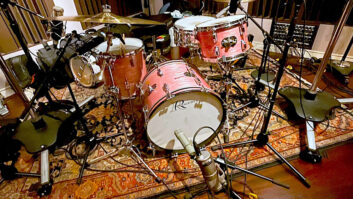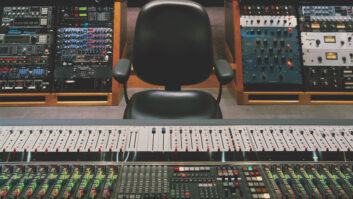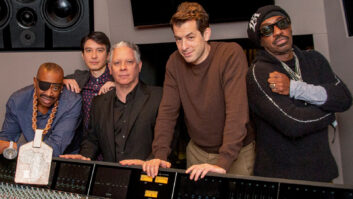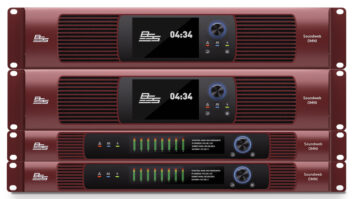Everyone needs a typical gear story to maintain historical perspective when products like the Yamaha DSP Factory come along to shatter price and performance expectations. Mine is about an untunable $3,000 guitar synthesizer that I financed; it sank a band in 1983, but that same $3,000 would today fund a 48-track, automated, computer-based, digital mixing and recording system replete with multiple effects, EQ and dedicated dynamics processing on every channel. Somehow that helps in keeping the whole studio-on-a-chip concept in perspective.
Yamaha’s DS2416 PCI audio card, the heart of the company’s DSP Factory system, conjures up no early-adopter technology nightmares whatsoever. In fact, it goes a long way to further the state of digital audio and MIDI production on the PC, for the price of a decent mic. This product was announced more than a year ago, and it’s finally here thanks to shipable Yamaha hardware and the good efforts of a half-dozen or so software developers. The DSP Factory seems to have been well worth the wait for people who do computer-based recording.
Limbo’ing in at just under a grand ($999), the DSP Factory offers 24-bit performance that will evolve to 32-bit when software exists to support it, 16 channels of playback, up to eight simultaneous record channels, two dedicated REV500 digital stereo effects processors, flexible digital routing options in the 24-channel virtual equivalent of a Yamaha 02R digital mixer, a host of great-sounding dynamics processors and musical 4-band parametric EQs on every channel, and a number of optional I/O and MIDI expansion units to pave the expansion pipeline.
The DS2416 card itself offers four analog stereo RCA I/O jacks and two coaxial digital ports, and there are optional AX44 Audio Expansion Cards ($299 each) that can piggyback with the card to provide analog-to-digital I/O ports that are front-mounted into empty and available 511/44-inch drive bays. The I/O boxes provide four unbalanced analog ins and four outs each, two inputs of which are switchable between line and mic input levels; and there’s a stereo headphone jack with its own front panel volume control. The analog inputs go through 20-bit A/D converters with 128x oversampling when capturing audio, the outputs are 20-bit with 8x oversampling going D/A, and the coaxial digital I/O ports will sync to other digital equipment in up to 24-bit wordlengths.
NAKED FOR NOWSurprisingly, the DSP Factory comes completely sans software-not even a basic audio control interface, just a handy little audio utility for testing the ports. Give Yamaha kudos for shaving software development dollars off the list price and assuming that most computer-based recordists are already using and/or happy with a host recording program, but those without recording software to access the DSP Factory’s laundry list of dedicated features are in for a very bad tease until some kind of supporting host software is installed. The actual “face” of the DSP Factory is completely dependent on the third-party software developed to take advantage of the DS2416 card, and so far the real estate looks pretty good.
I installed and used three PC packages that currently support and integrate the DSP Factory’s features: Steinberg’s Cubase VST/24, Minnetonka Sofware’s MXTrax for DSP Factory, and C-Console from C-Mexx. Though it’s far from the scope of this article to include comprehensive reviews of all DSP Factory-supporting software products and the ever-changing Read Me files, I will include comments on how each of these three host programs interfaces and interacts with the DS2416’s onboard tool set, as each program takes a different approach to integrating the card’s use. Many other software companies currently are supporting-or are soon to release-DSP Factory-savvy upgrades, including Cakewalk, Canam Computers, Emagic, Innovative Quality Software, Musicator, SEK’D and Sonic Foundry.
PC FRIENDLY?As is often the case with PCs, it took more than a little time to get the proper updated audio and MIDI hardware drivers correctly installed to support the newest DSP Factory-savvy host applications. The Yamaha-supplied PC I used to test the DSP Factory was a 233MHz Pentium II with 32 MB RAM and separate system and audio IDE drives, 4GB each. Two of the AX44 Audio Expansion Bays ($299) were installed. I un-installed both of these and the DS2416 card itself, and then re-installed them to check out the configuration process, which worked without a hitch. Thanks to what was apparently a bumpy ride in its flight case, the computer eventually needed both the CD-ROM and floppy drive cables untangled, unplugged and reconnected after sporadic drive failures plagued the driver installation processes. But after some cuffs-up and hands-on with the drive cables and assorted ribbon connectors, all worked, and the installation process sailed on through. The DSP Factory’s Windows plug-and-play wizard automatically handles all IRQ and DMA settings upon reinstalling the DS2416 card and AX44 ports; the entire process went surprisingly smoothly compared to some other PC audio and MIDI installation hells.
Two DSP Factory cards can be “cascaded” together along with two more I/O boxes to create 32 tracks of digital audio playback (though there are still eight simultaneous record channels), 16 signal I/Os and four effects engines, all under the automatable onscreen control of the host audio software. The PCI card, I/O boxes and associated connectors do create a rather large tangle of bundled ribbon cables inside the PC. So, the prospect of connecting twice as many cables with an expanded DSP Factory setup becomes daunting to say the least, especially if a connector ever gets bumped or comes loose again. Installing ribbon connectors that are trimmed to exact lengths would free some space, or moving and re-installing other PCI and ISA cards in the system can make more room for additional cabling.
Curved-facade PCs, like my Gateway 200MHz Pentium, cannot forward-mount the DSP Factory AX44 units. This means a very inconvenient rear-panel I/O install is required, which kind of defeats the original purpose of getting the connectors up front. The standard square-looking PC boxes with lots of open available drives and 5-volt PCI card slots are the best for an expanding DSP Factory setup, especially if all the unit will be doing is recording, processing, and mixing audio and MIDI. The DS2416 card’s five dedicated processing chips greatly unburden the host CPU by taking over the computing chores of all the DSP Factory’s real-time effects, mixes and edits. Existing third-party audio plug-ins run better under the host program’s environment, which is a nice side effect of installing a DSP Factory system.
Each of these programs has its own way of representing onscreen what the DS2416 card has to offer inside. The degree to which the DSP features are explained in their respective owner’s manuals is vital, because that’s about all the information there is on using the card, beyond the DS2416’s own sparse documentation. In examples described below, I used Cubase VST/24, MXTrax, and C-Console to record and mix acoustic and electric guitars, electric bass and percussion solo instrumental tracks, and to transfer eight channels of ADAT into the PC. There were excessive effects and dynamics processing applied throughout the mixes during these projects in an attempt to tax the Factory and host system fully-far more than an average session would require. This makes the system’s hiccup-less playback and responsive touch in all the programs all the more impressive.
ACOUSTIC CUBASEI first tested the DSP Factory using Steinberg’s Cubase VST/24 Version 3.6 running on Windows 95. This new 24-bit version would not install and work with the DS2416 until the latest drivers from Yamaha were installed, but once it was in place, everything worked fine. I miked up my 1960 J-35 Gibson dreadnaught using an AKG C-1000 mic just off the neck, mixed in with some active EMG saddle pickup output. Both were plugged into the first two inputs of the AX44 box and mixed together within Cubase’s DSP Mixer window, and then I recorded a track of a familiar fingerpicked piece.
Though it did not rival the sound of high-end mic preamps (or mics), the track I got was a faithful, well-defined reproduction that sounded great. I recorded both 20-bit and 24-bit versions of the track, easily detecting the subtle improvements 4 bits have to offer, and I found the DSP Factory’s 4-band parametric EQs, various multi-effects and dynamics processors to be warm and detailed. There is a long list of DSP Factory processor algorithms available, including a stable of reverbs, delays, choruses, filters, distortion and amp simulations. Each provides quiet performance and integrates well alongside the many plug-ins already installed in my Cubase audio system.
Within Cubase, the DSP Factory is accessed via a new Yamaha DSP Factory pull-down menu found under Audio or via keyboard shortcuts. Separate windows control the Factory’s Input Console, Channel Overview, Bus/Aux Console, FX Editor and Output Patchbay interfaces; each has a similar look and feel, consistent with the Cubase environs. Opening up all the new DSP control windows can fill up a 17-inch monitor at decent resolutions, yet each looks consistent when opened alongside existing Cubase edit windows. In fact, the new DSP Factory Input Console within Cubase sort of mimics an 02R console, using many of the same function buttons and the matte, greyish background to look the part.
The FX Editor window in Cubase provides a simple horizontal slider interface to edit each program’s effects parameters, and when surfing for sounds, selecting new effect names via pull-down menus is a breeze-no hiccups in playback between programs. Special effects like a ring modulator, rotating speaker and reverse delay can be found among 38 other effect types, and user settings can be saved and retrieved, as well. Like any other function within Cubase, all the DSP Factory mixer and effects parameters can be automated using the Write and Read command, making this a powerful environment from which to control effects processing and sound design.
All of Cubase’s high-resolution 24-bit signals are passed to the DS2416’s inputs in 24-bit format. VST itself can be bypassed altogether in order to use just the DSP mixer components, or DSP Factory can be integrated into Cubase as an external mixer feeding into VST as two serial mixers. Though this doesn’t have to do with the DSP card itself, I want to comment on how Cubase incorporates virtual rotary knob controls compared to the other programs tested here. Whereas C-Console and MXTrax both have nadir-point-limited rotation in either direction, like a physical rotary pot, with Cubase it is fairly easy to jump from a completely null position on a rotary knob up to a fully-boosted one with the tiniest counterclockwise mouse movement beyond the nadir point. I found this bothersome when making critical edits to very hot EQ bands, for instance, where the instant boost in gain sends a 0 to +18dB spike to the outputs, or where the sudden leap in a delay’s feedback level can begin an endless loop that needs to be reset.
Knob ergonomics aside, Cubase VST offers a fantastic front end to the DSP Factory that makes it addictively easy to effect and route tracks. The new interface integrates with and complements the existing VST environment that is familiar to power users. The dedicated effects and EQs sound clear without being brittle, warm in the midrange and beefy in the bottom. And manipulating the parameters with Cubase’s new DSP Factory interface windows adds only more powerful tools to Steinberg’s already impressive audio power belt.
THE NAMESAKE’S SOFTWARETo take a look at how MXTrax for DSP Factory ($499) from Minnetonka Software harnesses the DS2416/DSP Factory, I recorded a live bass track along- side an imported stereo drum kit loop, then added some lead guitar parts to check out the Factory’s guitar effects algorithms. I took the bass signal straight into the AX44 input sans direct box, effects or amp, and then, using MXTrax’s unique channel-building interface, created a fat bass channel by simply dragging compressor, line attenuator and channel delay knobs onto the channel strip.
The program’s roll-your-own approach to creating user-defined channel strips allows you to create custom channels that aren’t cluttered with unused knobs, buttons and controllers. Need a spot of low EQ? Just drag and peel an EQ icon off the Components Toolbox palette directly onto the channel strip, and voila: The appropriate sculpted knobs and frequency select buttons appear. The classy control surface serves up a nice backdrop to the very responsive, 3D-looking knobs and buttons. My only complaint is that a channel with all the available components attached-i.e. one each of 4-band EQ, pan, dynamics, attenuation, phase, and channel delay controls-takes up more than a 17-inch monitor’s-worth of vertical display area and, consequently, can require a fair amount of up-down noodling to get from the lower fader to the upper reaches of the channel strips throughout a session.
MXTrax for DSP Factory was ported over from a Digital Audio Labs V8 version. This software displays a novel 11/44-inch onscreen phono plug icon when you are dragging virtual 02R “connections” from the track window into the proper mixer channel; the connection is canceled out by a circle with a line through it when an improper connection is attempted. Instead of being an integrated audio/MIDI program, MXTrax focuses just on audio tracking and the 02R-driven digital mixing power found in the DSP Factory. The onscreen controls are tactile and responsive, and rerouting each mixer channel’s signal to tape tracks or to different I/O card profiles is a simple right-click away.
As the name implies, MXTrax for DSP Factory is all about the DS2416. Every feature found in the card is supported by the software (also the case with Cubase). Basic tracking, cut, copy and paste features are provided, as well as markers, automation, and effects-routing controls to create basic audio arrangements within complex 02R mixer setups and effects settings. MXTrax’s gold-tinged interface is reminiscent of the look of Ensoniq’s Paris, and the custom-designed mixer channels show a whole different side of what the DSP Factory can look like to each user. The MXTrax mixer’s onscreen faders and channel strips are “actual size” renditions of a board, as well, which is designed to give onscreen fader moves more of a “feel.”
I found all the effects to sound great, save the DSP Factory’s guitar distortion, which is a bit thin and un-crunchy. The amp simulator did create some interesting spaces when applied to the bass track and drum groove sample loop I recorded, and the reverbs all sound great, especially if you like Yamaha reverbs. One inconvenience is that playback is interrupted whenever an EQ or other component is dragged onto a channel during play in MXTrax. A real-time wish list for future versions of this program would also allow the seamless addition of dynamics to a channel during playback and a scalable control surface display size to avoid excessive view scrolling. But MXTrax more than takes good advantage of the power of the DS2416 card in this current release. It’s well worth a look-see, especially if you haven’t already invested in one of the major software platforms.
MOVING TRACKS WITH C-MEXXC-Mexx Software’s C-Console takes a very different tack to supporting the DSP Factory. It works in tandem with multitrack digital audio recording software packages and digital multitrack recorder (DMR) machines to provide a full digital recording and mixing solution. It comes with an impressive screen full of DSP Factory 02R digital mixer controls, and C-Console also provides a simple record/playback transport interface for controlling any MIDI Time Code-savvy digital audio recorder or software application. It was easier than I thought it would be to interface C-Console with Cubase via MTC in order to record and play back tracks in tandem, and C-Console’s own implementation of a virtual 02R board is intuitive, well-designed and powerfully visual to use.
Each channel strip has a gain control and a crafty 4-band parametric EQ knob inner/outer ring arrangement that saves control surface space and is easier to dial into. There are also six aux send level controls; pan; a fader with track meter; toggle on/off switches for EQ, dynamics, channel delay and channel; and solo in place stereo assign and channel alias. Creating a quick, rough mix using C-Console’s automation’s write and read controls was a snap, with easy and quick ways to punch in mix moves, effects setting changes and routing assignments. I didn’t care for the rudimentary recorder transport control buttons that “feel” tiny and lightweight onscreen, but I liked the feel of every other control knob and fader in C-Console, especially the full-screen-sized red master level fader. Here’s an idea: How about the ability to display 16 mega-sized faders?
I used C-Console in tandem with Cubase to transfer eight analog ADAT tracks through a Mackie Designs 1604VLZ via the Yamaha AX44 breakout boxes, and after a brief handshake period, I was able to dump them right into Cubase, with great results. An upcoming Lightpipe card (see below) will make this an even smoother, faster and digitally cleaner operation. Switching back and forth between the Cubase recording and DSP Factory mixer interfaces shows just how much onscreen control there is at the PC power user’s fingertips these days for under a grand. Power features and subtle touches abound, like the way the last-touched onscreen knob or fader flashes to retrace where you left off in a mixer or edit screen, or the inviting and colorful EQ Editor window; these features show that C-Mexx has been working on this program quite a bit. On the other hand, be advised that the online documentation, though visually effective in the way it explains various processes and signal routing paths, has lost a lot grammarwise in the translation from German to English; it is very confusing and thin when explaining some key functions and interconnectivity issues.
The colorful and intuitive EQ Editor window in C-Console is way good, with a responsive four-curve display that shows the low, low-mid, hi-mid and high-frequency curves in varying colors. A resulting audible curve is drawn over all in black, and creating steep notch filters or complex curves is a breeze either by using the numerical input boxes or by mouse-grabbing the curves directly. A library of EQ settings is easily accessible, allowing users to dial through factory settings and user-defined programs. And there is a host of new features: Each of the 40 onscreen faders can be instantly switched from 0 dB to +10 dB with a right mouse click, there’s full support for MTC Sync and any MTC Remote-aware hardware digital recorder, and settings for 24/25/30 and 30 drop-frame sync modes are offered. Amazingly, the 288 onscreen rotary pots in C-Console’s main mixer display mode are easy to navigate, thanks to good color coding, an intelligent layout and a single main text readout line atop the interface that displays each selected parameter’s name and value instead of clogging up the control surface with the same data displayed under each control. Very clean.
PROMISES, PROMISESWhat the software developers have already accomplished in these early versions of DSP Factory-optimized programs is to build intuitive, stable and creative audio environments, and they leave it wide open as far as where the DSP Factory platform could lead from here. It will be interesting to see how Cakewalk, Sound Forge and other major PC software packages further integrate with DSP Factory. Time will also tell what the Macintosh versions will look like, but so far the schizophrenic “faces” of the DS2416 look pretty good.
Before the ink dries on this page, Yamaha is expected to extend the platform by shipping the first of many optional upgrade products for the Factory. The AX16-AT Audio Expansion Card will provide 16 channels of ADAT Lightpipe digital I/O for just $299. The AX88 analog expansion unit (retail $999) is expected by May; it’s an 8-channel, 24-bit I/O option that will further enhance inputs and output. The $699 SW-1000XG PCI Audio MIDI Card is already shipping. It combines a MIDI interface, AWM2 tone generator, additional DSP effects, the powerful XGLite MIDI editor software and a 12-track digital audio recorder. Minnetonka, Steinberg and others are also working on drivers that will allow the Yamaha 01V digital mixer to control the 02R digital mixer features directly, and Macintosh DSP Factory drivers are already available for download. At the rate CPU-centric recording and mixing technology is progressing, can 32-bit Palm Pilot versions be that far off?
Yamaha, 6600 Orangethorpe, Buena Park, CA 90620; 714/522-9011; fax 714/522-0103. Web site www.yamaha.com.







